Wind and Swell Forecast: A Guide for Surfing Enthusiasts
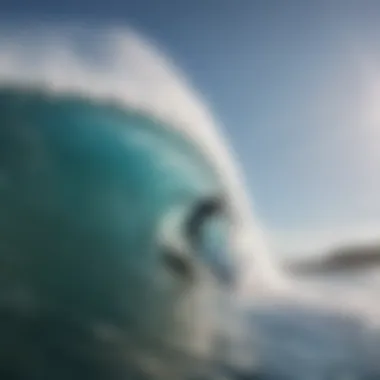
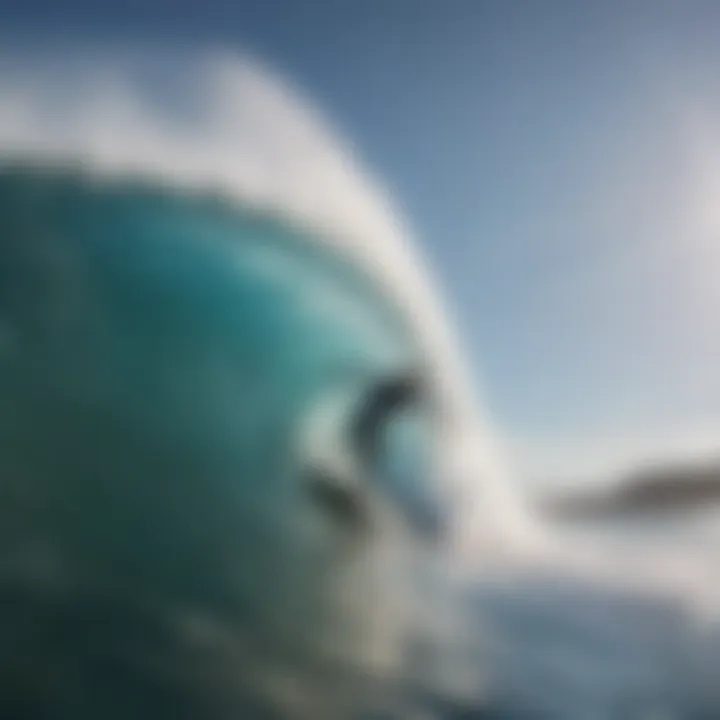
Intro
For surfers, the ocean is not just a body of water; it's a playground, a challenge, and a source of joy all rolled into one. But to truly harness the power of the waves, understanding the interplay of wind and swell becomes crucial. Surfers need to decode these elements to make the most out of their time on the board. This is where wind and swell forecasts come into play, acting as the guiding stars for any surfing adventure.
In the world of surfing, the forecast isn’t just a prediction—it’s an essential tool that can mean the difference between an exhilarating ride and a frustrating day in murky waters. Factors like wind direction, swell height, and local conditions are pieces of a puzzle that every surfer must learn to assemble. With that in mind, let’s dive into the realm of surfing techniques and equipment, keeping in sight how these connect back to understanding forecasts and improving the overall surfing experience.
Understanding Wind and Swell
When surfers contemplate favorable conditions for riding waves, the interplay of wind and swell emerges as a pivotal element. These natural forces not only dictate the quality of waves but also influence a surfer's experience on the water. Understanding how wind interacts with swell is crucial, as it aids in optimizing surf sessions and enhancing overall performance.
Knowing the nuances of wind and swell can significantly affect a surfer's outing. For instance, a light offshore breeze can maintain a wave’s shape and make for a smoother ride. Conversely, strong onshore winds can turn beautiful waves into choppy, unmanageable water, leaving surfers grappling for control. Therefore, it's essential to grasp these concepts for anyone aiming to truly enjoy their time on the water.
Defining Wind and Swell
To kick things off, let’s define what wind and swell actually are. Wind, in simple terms, is the movement of air across the surface of the Earth, often classified by its speed and direction. Whether it’s a gentle breeze or a howling gale, the wind sets the stage for wave formation. On the other hand, swell refers to the long-period waves that travel across the ocean, generated by distant storms or wind patterns. These waves are typically more organized and predictable compared to the choppy surface waves commonly seen in areas with local winds.
In surf forecasting, understanding the specifics of how these two elements work together is foundational. For instance, a swell created thousands of miles away can arrive at a beach perfectly shaped or completely ruined, depending on the accompanying wind conditions. Hence, keeping an eye on both aspects of the weather can make the difference between a day of exhilarating surfing and one filled with struggles.
The Role of Ocean Currents
Ocean currents are another piece of the puzzle of wind and swell that cannot be ignored. These currents are like hidden rivers within the ocean, moving vast amounts of water from place to place. They play a critical role in swell generation by affecting water movement and warmth, which further influences wave behavior.
When wind blows across the surface of the ocean, it pushes the water, generating waves. But it's not just the wind direction and speed that matter; the influence of ocean currents can enhance or detract from that process. For example, if the current is moving with the wind, it can help create more robust and powerful waves. On the flip side, if the current is moving against the wind, the waves may lose their energy and break more unpredictably.
Understanding both wind and ocean currents will add layers of complexity to your surf forecasting skills. As you gain insight into these interactions, your ability to predict surf conditions will improve dramatically, ensuring that when you hit the waves, you’re doing so at the optimal opportunity.
Geographical Influences on Forecasts
Understanding the geographical influences on wind and swell forecasts is like having a cheat sheet for surfers. It’s crucial to comprehend how regional traits shape surf conditions. These traits, such as coastal layout, depth of the sea floor, and prevailing wind patterns, have a direct impact on the quality of waves surfers can expect to ride. Knowing this can mean the difference between catching perfect waves and getting caught in choppy water.
Coastal Characteristics
Different coastlines offer varied surfing experiences. Imagine surfing in a location like Malibu, California versus the rocky shores of Portugal. The former has long, sandy beaches that allow the waves to build up nicely; while the latter can present powerful, more unpredictable swells. Coastal characteristics dictate not only the wave height but also their shape and frequency.
- Beach Orientation: The angle at which the beach meets the ocean affects how waves break. A beach facing directly into the swell will typically have better conditions for surfers. In contrast, beaches that are more oblique may have less consistent swell action.
- Substrate Variations: The floor beneath the ocean can vary widely. Areas with sandy bottoms will offer softer landings, whereas a rocky ocean floor may create dangerous conditions. For instance, surfers flock to Hawaii for its famous breaks, but it’s essential to know where it’s safe to surf amongst the coral reefs.
- Reef Structures: Some surfers prefer reef breaks, which generally yield faster and more hollow waves, while beach breaks tend to be more forgiving. Understanding these structures will assist surfers in choosing the right spot depending on their skill level and experience.
These coastal characteristics play a pivotal role in determining not just the height of the waves but also their behavior. Keeping an eye on local coastal geography can aid surfers in choosing the perfect surf spot.
Local Climate Patterns
Local climate patterns make the surf scene dynamic. They influence everything from water temperature to seasonal swells. A surfer who neglects to consider these patterns might walk into a situation where they’re not fully prepared.
- Seasonality and Storms: Different regions have storm seasons that can create excellent swell conditions. For example, during winter months, many spots on the East Coast of the United States receive robust swells due to nor'easters. Conversely, tropical storms can generate sizeable swells but are often accompanied by strong winds and unpredictable conditions.
- Temperature Effects: The local climate will dictate water temperatures, which can affect the choice of wetsuit. Surfers in Southern California might be comfortable in board shorts year-round, while those in the Pacific Northwest need to gear up for harsher conditions. Not being dressed appropriately can severely limit surf sessions.
- Wind Patterns: Local winds can transform an otherwise good day of surfing into a struggle. Onshore winds can create choppy waves, while offshore winds help groom waves for a clean face. Understanding local wind patterns will enable surfers to plan their sessions better.
Understanding the intersections of geographical features and local climate is essential for any serious surfer.
In sum, geographical influences on wind and swell forecasts serve as the cornerstone for intelligent surf planning. Recognizing the nuances of coastal characteristics and local climate patterns allows surfers to be proactive, maximizing their time on the waves while ensuring safety and enjoyment.
Mechanisms of Swell Generation
Understanding the mechanisms of swell generation is central to forecasting the surf conditions that every wave rider yearns for. When surfers grasp these dynamics, they equip themselves not just with knowledge, but with an ability to read the sea like a seasoned sailor. Weather patterns and ocean physics converge to create swells, which ultimately turn into the waves that enthusiasts chase. This section delves into two key aspects: wind speed and duration, as well as fetch length and direction. Both play vital roles in how swells are formed and how effective they become by the time they hit the shoreline.
Wind Speed and Duration
Wind is often called the artist of the ocean, crafting swells from seemingly calm waters. The interaction between wind speed and duration determines how much energy is transferred from the atmosphere to the surface of the sea. In simple terms, the faster the wind blows over the water, and the longer it sustains that speed, the larger and more organized the swell becomes.
For instance, strong winds gusting over a period of hours can kick up a veritable frenzy of waves. Surfers know that a quick look at the wind forecast can spell the difference between a disappointing outing and a day filled with epic rides. Long-standing winds of a higher velocity create swells that travel vast distances, culminating in a more coherent wave when they reach the beach.
- Wind speed above 15 knots typically starts producing rideable waves.
- Sustained winds over 24 hours can lead to swells that can travel hundreds of miles, gathering energy along the way.
Surfers should also be aware of how local topography can influence wind patterns. Areas sheltered by coastlines or islands experience less wind impact, creating different swell dynamics. Knowing these subtleties aids surf enthusiasts in selecting the right time to hit the waves.
Fetch Length and Direction
Fetch refers to the stretch of water over which the wind blows in a single direction. It's akin to a race track for energy. The longer the fetch, the more substantial the swell can become, as it gathers momentum. A swell generated from a long fetch possesses more uniformity and energy compared to one originating from a short fetch.
For example, imagine a wind starting at Point A and blowing straight towards Point B. If that distance is considerable, then the resulting swell is likely to arrive at the beach in better condition for surfing. On the contrary, swells generated from limited fetches may arrive jumbled and inconsistent, making for a less enjoyable experience.

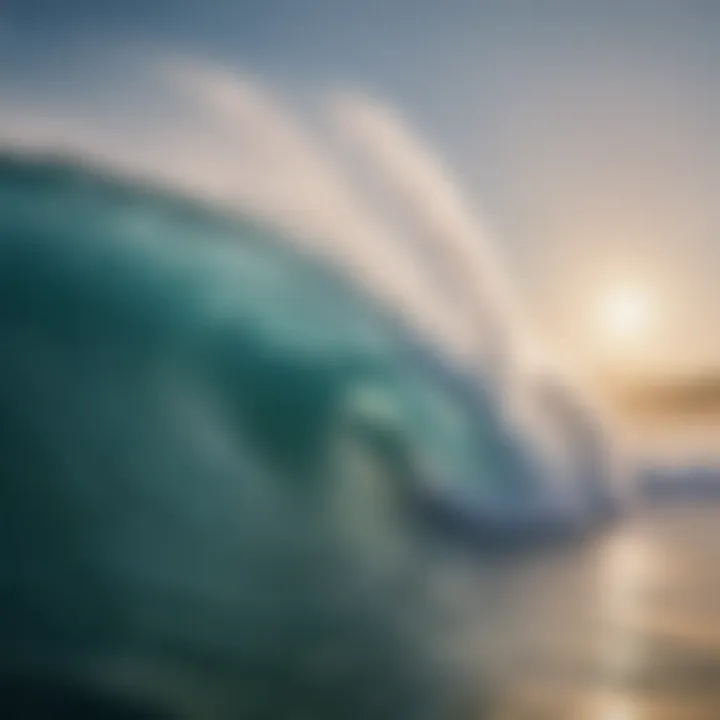
Some points of consideration regarding fetch include:
- Direction of Fetch: The direction the wind flows can either complement or clash with the sandbars and bathymetry of the area. Understanding this can help in anticipating wave shape and breaking quality.
- Geographical Barriers: Islands or coastal formations can alter the fetch length, redirecting winds and swells. This complexity is why local knowledge can often lead to finding better surf spots.
Overall, understanding the fetch dynamics alongside wind speed offers surfers deeper insights into surf conditions. This knowledge empowers them to make informed decisions and improves their overall water experiences.
"The sea, once it casts its spell, holds one in its net of wonder forever." - Jacques Cousteau
Tools for Forecasting
When it comes to mastering the waves, having access to reliable forecasting tools can make the difference between a thrilling surf adventure and a day wasted wishing the swell would pick up. The tools used in forecasting are crucial for determining not just when to hit the water, but also what conditions to expect. Understanding how to interpret the data provided by these tools equips surfers with the skills needed to choose their spots wisely and make the most of their time on the board.
Surf Forecast Websites
Surf forecast websites have become a go-to resource for enthusiasts looking to gain insight into upcoming conditions. These platforms gather and analyze a wealth of data, including wind speed, swell size, and tide information, and distill it into user-friendly readings. Websites such as Surfline, Magicseaweed, and Stormsurf provide detailed forecasts often split into hourly updates, which can help surfers plan their sessions around peak conditions.
- Real-time Updates: Regularly refreshed data gives surfers the freshest info at their fingertips.
- Local Spot Analysis: Many of these sites break down conditions for specific surf breaks, providing tailored insights that factor in local geography.
- Extended Forecasts: Users can often view trends over several days or weeks, helping in planning longer surf trips.
By leveraging these sites, surfers not only stay informed but can develop a deeper understanding of how different factors interplay to create optimal surf conditions. Often, there are community features like comment sections that allow surfers to share experiences, highlighting the importance of local knowledge.
Mobile Applications for Surfers
In today's fast-paced world, having a reliable surf forecast accessible on the go is invaluable. Mobile applications designed for surfers ensure that crucial data is only a tap away, allowing for quick decision-making whether on the road or at the beach. Apps like Windy, Surfy, and iSurf offer similar benefits to their website counterparts, with the convenience of mobile access.
- User-Friendly Interface: Most apps are designed for intuitive navigation, allowing surfers to quickly get the information they need.
- Push Notifications: Many of these applications allow users to set up alerts for when specific conditions are met, ensuring they won’t miss a swell.
- Offline Functionality: Certain apps enable users to download forecasts for offline use, which is especially helpful in remote surfing spots with limited service.
Having these apps enhances the ability to stay updated and responsive to changing conditions, making them essential tools for any serious surfer's kit.
Using Buoy Data Effectively
Buoy data is one of the more technical aspects of marine forecasting that surfers can utilize for pronounced advantages. Ocean buoys collect real-time data about wave heights, periods, and even sea temperature, giving surfers a granular view of conditions far from the shore. Understanding how to interpret this data can significantly enhance one's ability to predict upcoming surf conditions accurately.
- Wave Height and Period: Key metrics found in buoy reports, these figures help discern whether the swell will translate into rideable waves based on documented conditions.
- Weather Patterns: Buoys also measure wind speed and direction, which can inform about potential changes in conditions.
To glean useful insights from buoy reports, surfers should familiarize themselves with various buoy databases, such as NOAA and Surfline. By tracking trends within this data, surfers can begin to anticipate which days will offer the best conditions at their chosen spots.
"It's not enough to simply check a surf report; understanding and interpreting buoy data can put you ahead of the game on any given day."
With the right forecasting tools at hand, surfers can boost their chances of finding those perfect waves, ultimately enhancing their overall surfing experience.
Decoding Wind Forecasts
Wind forecasts are like a compass for surfers; they indicate which way to go for the best rides. No one wants to paddle out only to discover the conditions are less than ideal. Understanding wind patterns can make the difference between a thrilling day on the waves and a disappointing one spent frustrated on the shore. In this section, we’ll break down essential elements that come into play in wind forecasting, highlighting their benefits and what surfers should consider.
Understanding Wind Vectors
Wind vectors are essential to grasping the nuances of wind behavior. Essentially, a wind vector represents both the speed and direction of the wind at any given time. In many forecasts, this is depicted through arrows on weather maps. The length of an arrow signifies wind speed—longer arrows indicate stronger winds, while shorter ones denote lighter breezes. Knowing the wind direction helps surfers predict how the waves will break and interact with local conditions.
For example, if you see a north-west wind at a surf spot, it's crucial to know that this can create a smooth surf with better quality waves, especially if the coastline is oriented to catch these winds. Conversely, a wind coming from the east may lead to choppy conditions that ruin what could otherwise be perfect waves.
Key Takeaways on Wind Vectors:
- Direction Matters: Knowing if the wind is offshore or onshore can drastically change wave conditions.
- Speed Significance: Higher speeds can generate bigger waves but can also make them tricky to ride.
- Local Landscape: Coastal features can alter how wind affects the surf zone.
Interpreting Wind Speeds
Interpreting wind speeds within forecasts is just as important as understanding vectors. Wind speed is measured in knots or miles per hour, and different ranges can signal distinct conditions for surfers.
- Light Winds (0-10 knots): This range typically offers the best surf conditions, allowing for smooth breaking waves and a more enjoyable ride. Surfers might want to get in the water whenever the predicted speeds fall into this category.
- Moderate Winds (11-20 knots): Conditions can begin to become choppy, which might not be ideal for beginners. Nevertheless, experienced surfers can still enjoy some good swells, especially if the winds are offshore.
- Strong Winds (21+ knots): This can lead to chaotic surf conditions. While big wave surfers might look forward to such days, most will find it challenging to maintain control on their boards. In this case, patience might just be the key—waiting for the winds to mellow can pay off with cleaner waves later in the day.
Interpreting wind speeds isn't just about numbers; it requires keeping an ear to the ground (or rather, the surf report). Surfing communities often offer localized insights that can help refine forecasts, providing a more rounded understanding of how wind will transform surf conditions.
"To surf is to live, and knowing your winds is part of that life. Surf forecasts are only as good as the information they’re based upon, understanding what you're looking at is key."
Recognizing how wind vectors and speeds interact forms a critical part of any surf forecast. After mastering these skills, surfers can go forth equipped with the knowledge necessary to make informed decisions, ensuring the best chances for catching epic waves.
Swell Period and Its Importance
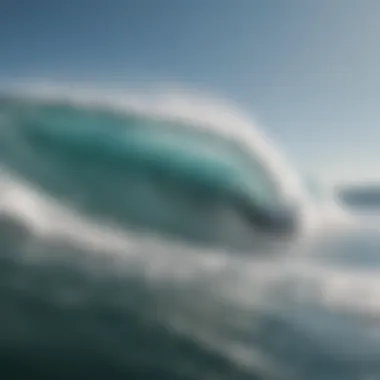
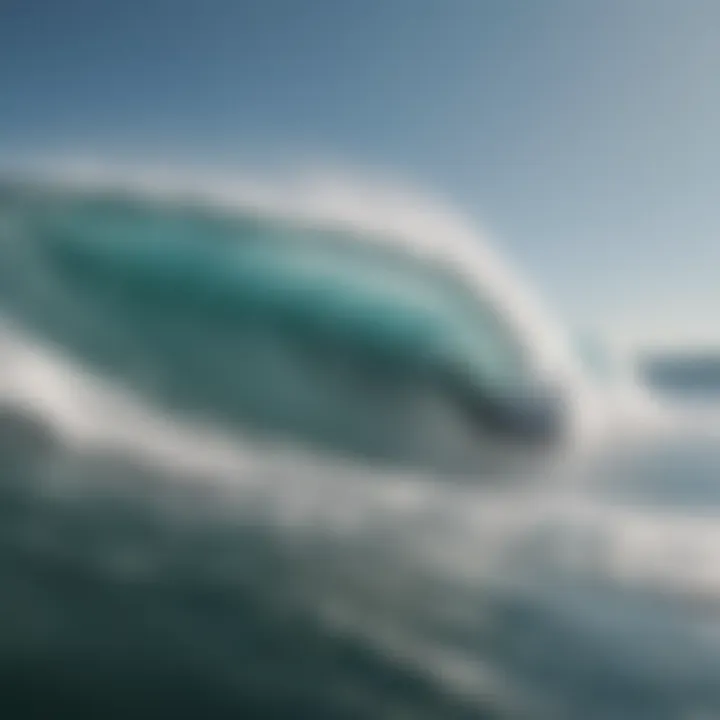
Understanding the swell period is crucial for surfers aiming to master the waves. The swell period, essentially, garners significant attention because it directly correlates with wave quality and energy. In the realm of surfing, where conditions can change with the shift of the tide or a gust of wind, being knowledgeable about swell periods can be the difference between an exhilarating session and a less than ideal one.
Swell Period Explained
The swell period refers to the time between successive waves as they travel. This is not merely about counting seconds; it’s about understanding how the waves' duration impacts your ride.
To break it down:
- Short periods (less than 8 seconds) typically result in choppy, less organized waves. These are the conditions that can leave an ambitious surfer feeling frustrated.
- Medium periods (8 to 12 seconds) begin to show some promise, as waves grow more structured and start to pack in energy. They offer more consistent surf, affecting not just the wave height but also how they break upon reaching the shore.
- Long periods (over 12 seconds) often herald the arrival of powerful and clean swells. These waves generally carry more energy, travel longer distances, and tend to provide surfers with a smoother ride. This is where the magic happens, leading to thrilling rides and more impressive maneuvers.
It's essential to keep in mind that these time frames can greatly affect how the ocean behaves as well. So, when surfers check a report and notice the swell period, they're looking beyond just what the waves will look like—they're gauging how enjoyable, and safe, the surf will be.
Impact on Wave Quality
When we talk about wave quality, the swell period is a key player. Longer swell periods can create waves that are not only more reliable but also more fun to surf.
- Consistency: With longer periods, waves come in sets that offer regular bursts of surfable moments. This means less time spent waiting and more time catching rides.
- Power: More time between waves allows for energy retention, leading to steeper, more powerful waves when the swell hits the beaches.
- Shape: Waves generated from longer periods have more natural shaping as they break. This translates to cleaner lines, which are a delight for surfers and a challenge for tricks.
To get the most out of each surfing session, understanding swell period is non-negotiable. It’s not just about the height; it’s about the rhythm and energy that dictates how enjoyable your experience will be.
In summary, surfer enthusiasts should always pay attention to the swell period in their forecasts. By doing so, they can significantly improve their chances of experiencing quality surf conditions. Surfing isn't just about the thrill; it's about knowing the ocean intimately enough to dance with its waves.
Navigating Compounding Factors
When riding the waves, it's not just about the wind and swell; other factors come into play that can drastically change your experience. Understanding these compound influences can make the difference between a stellar surf session and a frustrating day on the beach. Here, we focus on two critical elements: tides and weather systems. Each of these factors adds a layer of complexity to the forecast. Ignoring them could lead to subpar conditions and potential hazards while surfing.
Tides and Their Effects
Tides are often underestimated by surfers, but they hold remarkable sway over wave quality and break dynamics. The gravitational pull of the moon and sun plays a significant role in shifting water levels throughout the day. There are two high tides and two low tides in a typical 24-hour period, created by the earth's rotation and the positioning of celestial bodies.
- High vs. Low Tides:
During high tide, waves tend to have more power, making wave faces steeper, which can be great for advanced surfers looking for that exhilarating ride. However, too much water can cause peaks to become mushy or difficult to catch for beginners. On low tide, waves may be weaker but can create perfect conditions for those learning the ropes, allowing more control and easier rides. - Timing:
The critical aspect is timing your session with the peak tide conditions at your favorite surf spot. Some breaks work perfectly an hour or two after low tide, while others shine during high tide. A simple local guide or even community forums, like the ones on reddit.com, can share insights about how tides affect local breaks.
Don’t forget to also observe tidal graphs; knowing them can help you find the sweet spot for your surf sessions.
Weather Systems and Fronts
Weather systems can have a profound impact on surf conditions, altering everything from wave size to wind direction. A storm brewing miles away might send swells that, depending on their quality, can produce epic rides. But not all weather systems generate the same results; hence, understanding how to read them is key.
- Cold and Warm Fronts:
Cold fronts tend to bring gusty winds and increased wave energy because they can steepen wave formation, while warm fronts may create a more peaceful surf environment but can also lead to choppy conditions. - Pressure Systems:
Understanding high and low-pressure systems is also vital. Low pressure is generally associated with stormy weather but can generate sizable, quality swells as they move into your area. Meanwhile, high-pressure systems often bring calm weather but can lead to smaller surf.
Incorporating weather forecasting into your routine is as important as checking swell reports. Tools like Windy or surf-related apps can sometimes even predict these systems.
Local Knowledge and Its Value
Understanding the dynamics of wind and swell forecasts is just one piece of the puzzle for surfers. Equally important is the local knowledge that comes from spending time in the water and observing the interplay of conditions at particular surf spots. This depth of familiarity can elevate one's surfing experience significantly.
Local knowledge includes insights into the way a surf break works, which can vary tremendously even over short distances. Each surf spot has its personality, shaped by the local geography, ocean currents, and seasonal changes. Surfers well-versed in the intricacies of their beloved breaks are often quick to identify the optimal conditions for riding waves, be it from scouting sandbars or watching the tide rise or fall.
Building Familiarity with Surf Spots
Gaining knowledge about particular surf spots can take some time and practice. When you surf at the same locations regularly, you start picking up on patterns that others might miss. For example, you might notice how the swell direction changes with the seasons or how certain rocks or reefs can create ideal barrels when the conditions align. This can be particularly advantageous if you're looking for less crowded waves.
Consider the following factors that contribute to building familiarity:
- Local Wind Patterns: Understanding how wind interacts with your surf spot helps determine when it's best to hit the waves.
- Best Times to Surf: Knowledge about peak swell times or the ideal tide for different breaks can make all the difference in your surfing outings.
- Safety Considerations: Being aware of local hazards, such as rocks, currents, and marine life, contributes to safer surfing practices.
Through repeated exposure, surfers develop a relationship with the water that is nearly intuitive. They learn not just to read forecasts but also to interpret conditions on the fly, enhancing their ability to choose the right time to hit the waves. This intrinsic understanding can be the difference between a lackluster session and a day filled with exhilarating rides.
Community and Shared Experiences
Surfing is not just a solitary sport; it's deeply embedded within community. Engaging with fellow surfers can vastly enrich your understanding of local conditions. Sharing experiences offers new perspectives that can enhance one’s ability to read wind and swell forecasts.
Consider participating in local surf groups, workshops, or forums. Here are some benefits of community involvement:
- Exchange of Knowledge: Insights from more experienced surfers can lead to improved surfing technique and safety awareness.
- Access to Local Wisdom: Members of the surfing community often have invaluable knowledge about specific conditions on particular days, gathered from years of experience.
- Support Network: Whether you’re looking for a surf buddy or advice on gear, local surfers can provide valuable recommendations and connections.
"Show me your friends, and I’ll show you your future." This idiom rings especially true in the surfing world, where your surfing community can shape how you experience the ocean.


The shared connection among surfers promotes an environment where individuals can learn and grow together, celebrating the joy of surfing while also fostering respect for the nuances of the local environment. Being part of such a community not only strengthens one’s skills but also deepens an appreciation for the surf culture that thrives in harmony with nature.
Practical Application of Forecasts
Understanding how to effectively utilize wind and swell forecasts is key for surfers who want to optimize their time in the water. It's not just about catching a wave; it's about choosing the right wave at the right time to ensure a safe and enjoyable experience. Familiarity with these forecasts helps surfers make more informed decisions, improving their skills and satisfaction.
Identification of Optimal Surf Conditions
Identifying optimal surf conditions involves more than just checking the swell size. Surfers need to appreciate a variety of factors that come into play. Here are some of the core elements to consider:
- Swell Height: Larger swells, usually ranging from two to six feet, indicate potentially powerful waves, but the suitability of these swells can differ by location.
- Swell Period: The time between swells is crucial. A longer period often translates to better quality waves. For surfers, this can mean the difference between a choppy surf and a smooth ride.
- Wind Direction: Offshore winds are generally favorable, as they help to groom the waves. Onshore winds, conversely, can create less desirable conditions.
These elements can be tracked through various forecasting tools, allowing surfers to determine the right time to hit the beach. By getting familiar with regional swells, surfers increase the chance of finding favorable conditions.
"Understanding how swell timing and wind influence the ocean can be the difference between a ride and a wipeout."
Planning Surf Sessions Accordingly
Once surfers have identified the optimal conditions, the next step is to plan their surf sessions around these forecasts. Keeping a few key points in mind can significantly enhance this planning process:
- Time of Day: Early mornings and late afternoons frequently provide more favorable winds. It’s also when tides can have a significant impact, either filling in or washing away the sandbanks that shape waves.
- Crowd Factors: Popular surf spots can become congested, especially on weekends. Being aware of peak times allows surfers to schedule their sessions for less competitive waves.
- Weather Conditions: Beyond wind and swell, other weather elements like air temperature and precipitation can affect both comfort and performance. It’s wise to check forecasts not just for the ocean but for the entire day.
- Equipment Readiness: Having the right gear ready to go can make or break a session. If there’s a good swell running and a window available, having boards and wetsuits prepared ahead of time is crucial.
In summary, understanding practical applications in forecasting empowers surfers to make well-informed decisions. This not only translates to better wave riding but also elevates the overall surfing experience by fostering a deeper connection with oceanic patterns.
Sustainable Forecasting Practices
Sustainable forecasting practices are becoming essential in the world of surfing, as environmental awareness takes center stage. This section will explore how surfers can align their passion for the sport with ecological responsibility. Understanding and implementing sustainable forecasting not only contributes to personal enjoyment but also to the health of oceans and coastal ecosystems. As surfers, the sentiments of our surroundings profoundly influence our experiences on the waves. Therefore, grasping the nuances of sustainability helps coastal communities and individuals alike.
Integrating sustainable practices in forecasting means focusing on how various factors, such as climate change, pollution, and ocean conservation efforts, affect swell patterns and surf conditions. Without a solid understanding of these elements, one might find surfing reduced to a mere thrill-seeking endeavor, jeopardizing the natural beauty and resources we often take for granted. Thus, it is imperative to marry surfing with sustainability, benefitting both the surfers and the aquatic environments they cherish.
Integrating Environmental Data
Integrating environmental data into surf forecasting is key to fostering sustainability. This involves leveraging information on water quality, marine life, and weather patterns to make informed decisions. For instance, surfers can check resources like NOAA's data for insights on water temperature and pollution levels. Surfing in areas with clean water not only ensures a safer experience but also minimizes the impact on aquatic life.
Moreover, understanding the relationship between swell generation and climate patterns can help surfers choose times when conditions are not just optimal for riding but also for protecting fragile ecosystems.
- Understanding shifting weather patterns can clarify when specific beaches are most affected by seasonal changes.
- Observing marine biodiversity in certain areas can influence when and where to surf, considering nesting seasons for local marine life.
A responsible surfer should always keep an eye on the environment, knowing full well that it directly correlates with their surfing conditions.
Promoting Ecosystem Awareness
Promoting ecosystem awareness serves as the backbone of sustainable forecasting practices. Surfers should embrace the role of stewards of the ocean, advocating for conservation efforts that maintain the pristine nature of their beloved surf spots. This goes beyond just riding waves; it's about nurturing the environment that sustains the sport.
Local organizations and surf communities play a vital role in disseminating knowledge about the health of marine ecosystems. Participating in beach clean-ups and supporting initiatives aimed at reducing plastic waste can make a tangible difference.
It's beneficial to encourage fellow surfers to:
- Learn about local ocean currents and how they affect marine life.
- Stay informed about pollution levels and engage in advocacy for stricter regulations.
- Share information on social media platforms like Facebook and Reddit to reach broader audiences.
"A single wave can only ride for so long, but a community united for the ocean can create ripples of change."
By fostering a culture of awareness, surfers not only enhance their own experiences on the water but also contribute to the longevity and vitality of coastal environments. This integrative approach between monitoring surf conditions and being conversant with environmental issues lays the groundwork for a sustainable relationship with our oceans.
Epilogue
The importance of synthesizing the intricate details of wind and swell forecasting cannot be overstated for those who are deeply passionate about surfing. A thorough understanding of key elements such as wind vectors, swell generation mechanisms, and local conditions can significantly enhance the surfing experience. When surfers are aware of how these components interact, they can make informed decisions about when and where to hit the waves.
Summarizing Key Insights
In summary, we have delved into the various aspects of wind and swell forecasts. Here’s a concise recap:
- Wind and Swell Dynamics: Recognizing the interplay between wind patterns and ocean currents can open a new level of understanding about wave creation.
- Geographic Impact: The coastal features and climatic patterns of a specific region can shape the surf conditions remarkably.
- Tools and Resources: Utilizing advanced surf forecasting websites and mobile applications enables surfers to stay ahead of changing conditions.
- Environmental Considerations: Embracing sustainable practices ensures that the surfing environment remains viable for future generations.
Together, these insights create a robust framework for predicting surf conditions and optimizing the surf experience.
Encouraging Continuous Learning
Staying updated in the ever-changing world of surfing is crucial. Engaging with various resources can broaden understanding.
- Join Local Surf Communities: Connecting with local surfers on platforms like Reddit or through Facebook groups can provide real-time insights and shared experiences.
- Participate in Workshops: Many surf schools offer workshops focusing on weather analysis and oceanography. These sessions can help surfers grasp complex forecasting techniques.
- Read Articles and Research Papers: Keeping an eye on new articles, such as those on Britannica or Wikipedia, helps in learning about new developments in ocean sciences.
"Knowledge is the wave that drives the surfs – without it, you're just spinning your wheels in shallow waters."
By cultivating a mindset geared towards continuous learning, surfers can evolve not just in their skills but in their comprehension of the environment they cherish. Embracing change and adaptation will only serve to deepen the joy of surfing, allowing each individual to ride the waves of knowledge as eagerly as the waves themselves.















